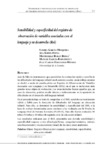Mostrar o rexistro simple do ítem
Sensibilidad y especificidad del registro de observación de variables asociadas con el lenguaje y su desarrollo (Rol)
| dc.contributor.author | García-Mosquera, Sandra | es_ES |
| dc.contributor.author | López-Osuna, Ana | es_ES |
| dc.contributor.author | Durán-Bouza, Montserrat | es_ES |
| dc.contributor.author | García-Fernández, Manuel | es_ES |
| dc.contributor.author | Fernández-Méndez, Juan Carlos | es_ES |
| dc.date.accessioned | 2014-10-02T12:42:55Z | |
| dc.date.available | 2014-10-02T12:42:55Z | |
| dc.date.issued | 2014 | es_ES |
| dc.identifier.citation | Encuentros sobre psicología, comunicación y lenguaje, 2014: 111-126. ISBN: 978-84-9749-585-1 | es_ES |
| dc.identifier.isbn | 978-84-9749-585-1 | es_ES |
| dc.identifier.uri | http://hdl.handle.net/2183/13544 | |
| dc.description.abstract | [Resumen] Ante la falta de instrumentos que permitirían la evaluación rápida y sencilla de las dificultades del lenguaje infantil en el contexto escolar, en un trabajo anterior se diseñó a modo de prueba piloto un Registro de Observación de Variables Asociadas con L enguaje y su Desarrollo (ROL) en el que se incluyeron siete grandes áreas objeto de evaluación. L as áreas incluidas fueron aquellas que, en caso de alteración, podrían incidir directa o indirectamente en la aparición de dificultades en el desarrollo del lenguaje infantil. En el presente trabajo se trató de comprobar si el ROL resultaba un instrumento válido y fiable para la detección de dificultades del lenguaje en educación infantil. Para ello, se determinó la sensibilidad y especificidad del ROL a la hora de evaluar determinadas áreas similares a las evaluadas por la Prueba de Lenguaje Oral de N avarra Revisada (PLON-R). Para ello fueron evaluados 98 niños (54 niños y 44 niñas) de segundo ciclo de educación infantil. Los resultados indicaron que el ROL presentaba una elevada sensibilidad y especificidad respecto a tres (fonología/forma, categorías/semántica, órdenes sencillas/atención y reconocimiento visual) de las cinco áreas analizadas | es_ES |
| dc.description.abstract | [Abstract] In the absence of tools for quick and easy assessment of child language difficulties in the school context, in a previous paper was designed as a pilot test a record to assess oral language which included seven major areas. Areas involved were those that, when altered, could either directly or indirectly affect the occurrence of difficulties in child language development. This paper checks if the Observational Record Variables A ssociated with Developmental L anguage (ROL) was a valid and reliable tool for detecting language difficulties in early childhood education. For this, the sensitivity and specificity of the ROL to evaluate specific areas similar to those assessed by the For this, the sensitivity and specificity of ROL was determined assessing specific similar to those assessed by the Test of Oral L anguage N avarra Revised (PLON-R) areas. The assessment was performed at 98 children (54 boys and 44 girls) second cycle early childhood education. The results indicated that the ROL had a high sensitivity and specificity for three (phonology/form, categories/semantics, simply orders/ attention and visual recognition) of the five areas analyzed. | es_ES |
| dc.language.iso | spa | es_ES |
| dc.publisher | Universidade da Coruña | es_ES |
| dc.subject | Registro observación lenguaje | es_ES |
| dc.subject | Sensibilidad | es_ES |
| dc.subject | Especificidad | es_ES |
| dc.subject | Educación infantil | es_ES |
| dc.subject | Language observational record | es_ES |
| dc.subject | Sensivity | es_ES |
| dc.subject | Specificity | es_ES |
| dc.subject | Early childhood education | es_ES |
| dc.title | Sensibilidad y especificidad del registro de observación de variables asociadas con el lenguaje y su desarrollo (Rol) | es_ES |
| dc.type | info:eu-repo/semantics/conferenceObject | es_ES |
| dc.rights.access | info:eu-repo/semantics/openAccess | es_ES |






